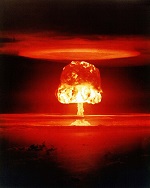
High atop a tower in the New Mexico desert, the world's first nuclear bomb was detonated in a test called Trinity on a July day in 1945. People over 100 miles away could see the mushroom cloud. No one knew then how far the fallout would go, but now a study shows that within 10 days the radioactivity had reached 46 states, Canada, and Mexico.
As depicted in the biopic, Oppenheimer, the Trinity test ushered in a new age of nuclear weapons testing that culminated in the bombing of two Japanese cities and ended in 1992 having set off over a thousand nuclear explosions.
Recently, scientists reconstructed the weather the day Trinity exploded by charting weather patterns extending thirty thousand feet up. Using this data, researchers could track the fallout of Trinity and the nearly 100 tests that followed.
They could estimate ground deposits of radioactivity for the first five days after each test. It revealed that northeastern New Mexico was heavily impacted. There are stories of children playing with the ash like snow, trying to catch it on their tongues.
Despite the passage of the Radiation Exposure Compensation Act, many in New Mexico have been denied. About half a million people lived within 115 miles of the test site. They weren't warned and many have since died of cancer. Even though the US and Russia have been reducing their nuclear stockpiles, countries like China and North Korea may be producing more.
You can now hear additional episodes on many of your favorite podcast providers - visit Buzzsprout to subscribe.
More Information
Trinity Nuclear Test's Fallout Reached 46 States, Canada and Mexico, Study Finds
The research shows that the first atomic bomb explosion's effects had been underestimated, and could help more "downwinders" press for federal compensation...
SGS Maps Radioactive Fallout from U.S. Nuclear Weapon Tests, Beginning with July 1945 Trinity Test
SGS has released research showing in unprecedented detail the spread of radioactive fallout from 94 continental U.S. atmospheric nuclear weapon tests, including the first nuclear weapon test - the 16 July 1945 Trinity explosion that was a key part of the Manhattan Project. This work has been reported in The New York Times...
Fallout from U.S. atmospheric nuclear tests in New Mexico and Nevada (1945-1962)
One hundred and one atmospheric nuclear weapon tests were conducted between 1945 and 1962 in the United States, resulting in widespread dispersion of radioactive fallout, and leading to environmental contamination and population exposures. Accurate assessment of the extent of fallout from nuclear weapon tests has been challenging in the United States and elsewhere, due to limited monitoring and data accessibility. Here we address this deficit by combining U.S. government data, high-resolution reanalyzed historical weather fields, and atmospheric transport modeling to reconstruct radionuclide deposition across the contiguous United States, with 10-kilometer spatial and one-hour temporal resolution for five days following detonation, from all 94 atmospheric tests detonated in New Mexico and Nevada with fission yields sufficient to generate mushroom clouds...